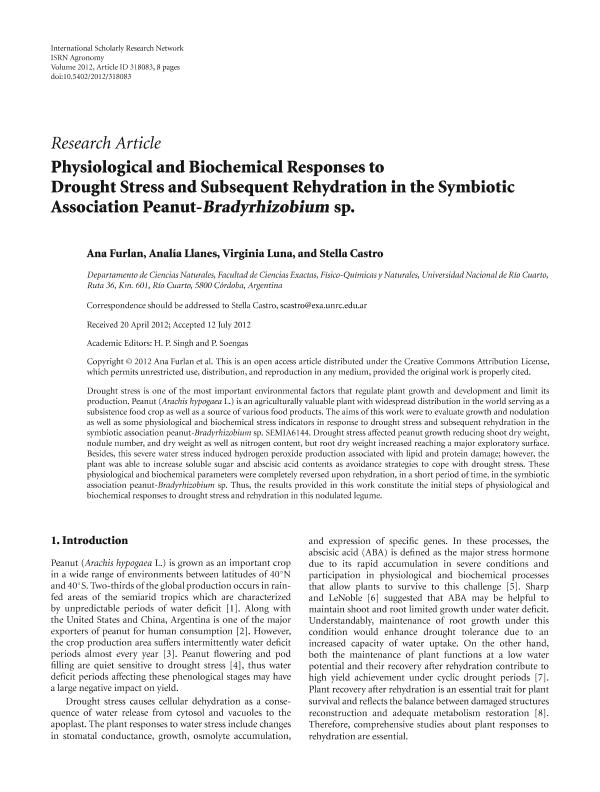Mostrar el registro sencillo del ítem
dc.contributor.author
Furlan, Ana Laura

dc.contributor.author
Llanes, Analia Susana

dc.contributor.author
Luna, Maria Virginia

dc.contributor.author
Castro, Stella Maris

dc.date.available
2023-06-08T13:35:32Z
dc.date.issued
2012-10
dc.identifier.citation
Furlan, Ana Laura; Llanes, Analia Susana; Luna, Maria Virginia; Castro, Stella Maris; Physiological and biochemical responses to drought stress and subsequent rehydration in the symbiotic association peanut-Bradyrhizobium sp; Hindawi Publishing Corporation; International Scholarly Research Notices; 2012; 10-2012; 1-8
dc.identifier.issn
2090-7664
dc.identifier.uri
http://hdl.handle.net/11336/199991
dc.description.abstract
Drought stress is one of the most important environmental factors that regulate plant growth and development and limit its production. Peanut (Arachis hypogaea L.) is an agriculturally valuable plant with widespread distribution in the world serving as a subsistence food crop as well as a source of various food products. The aims of this work were to evaluate growth and nodulation as well as some physiological and biochemical stress indicators in response to drought stress and subsequent rehydration in the symbiotic association peanut-Bradyrhizobium sp. SEMIA6144. Drought stress affected peanut growth reducing shoot dry weight, nodule number, and dry weight as well as nitrogen content, but root dry weight increased reaching major exploratory surface. Besides, this severe water stress induced hydrogen peroxide production associated with lipid and protein damage; however, the plant was able to increase soluble sugar and abscisic acid contents as avoidance strategies to cope with drought stress. These physiological and biochemical parameters were completely reversed upon rehydration, in a short period of time, in the symbiotic association peanut-Bradyrhizobium sp. Thus, the results provided in this work constitute the initial steps of physiological and biochemical responses to drought stress and rehydration in this nodulated legume.
dc.format
application/pdf
dc.language.iso
eng
dc.publisher
Hindawi Publishing Corporation

dc.rights
info:eu-repo/semantics/openAccess
dc.rights.uri
https://creativecommons.org/licenses/by-nc-sa/2.5/ar/
dc.subject
DROUGHT
dc.subject
BIOCHEMICAL RESPONSES
dc.subject
BRADYRHIZOBIUM
dc.subject
PEANUT
dc.subject.classification
Biotecnología Agrícola y Biotecnología Alimentaria

dc.subject.classification
Biotecnología Agropecuaria

dc.subject.classification
CIENCIAS AGRÍCOLAS

dc.title
Physiological and biochemical responses to drought stress and subsequent rehydration in the symbiotic association peanut-Bradyrhizobium sp
dc.type
info:eu-repo/semantics/article
dc.type
info:ar-repo/semantics/artículo
dc.type
info:eu-repo/semantics/publishedVersion
dc.date.updated
2023-06-07T15:15:41Z
dc.journal.volume
2012
dc.journal.pagination
1-8
dc.journal.pais
Estados Unidos

dc.journal.ciudad
New York
dc.description.fil
Fil: Furlan, Ana Laura. Consejo Nacional de Investigaciones Científicas y Técnicas. Centro Científico Tecnológico Conicet - Córdoba; Argentina. Universidad Nacional de Río Cuarto. Facultad de Ciencias Exactas Fisicoquímicas y Naturales; Argentina
dc.description.fil
Fil: Llanes, Analia Susana. Consejo Nacional de Investigaciones Científicas y Técnicas. Centro Científico Tecnológico Conicet - Córdoba; Argentina. Universidad Nacional de Río Cuarto. Facultad de Ciencias Exactas Fisicoquímicas y Naturales; Argentina
dc.description.fil
Fil: Luna, Maria Virginia. Universidad Nacional de Río Cuarto. Facultad de Ciencias Exactas Fisicoquímicas y Naturales; Argentina. Consejo Nacional de Investigaciones Científicas y Técnicas. Centro Científico Tecnológico Conicet - Córdoba; Argentina
dc.description.fil
Fil: Castro, Stella Maris. Universidad Nacional de Río Cuarto. Facultad de Ciencias Exactas Fisicoquímicas y Naturales; Argentina
dc.journal.title
International Scholarly Research Notices
dc.relation.alternativeid
info:eu-repo/semantics/altIdentifier/doi/http://dx.doi.org/10.5402/2012/318083
Archivos asociados
